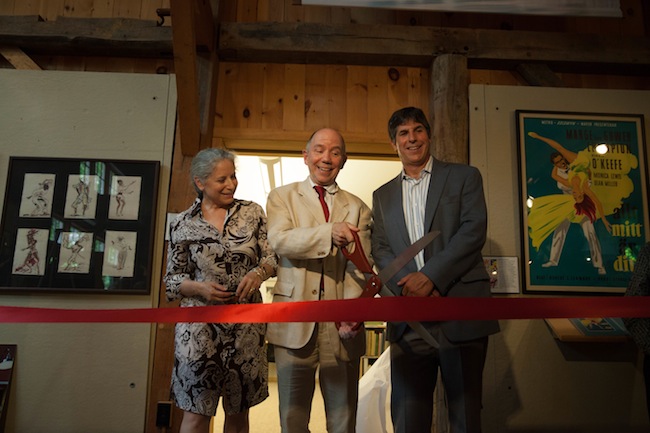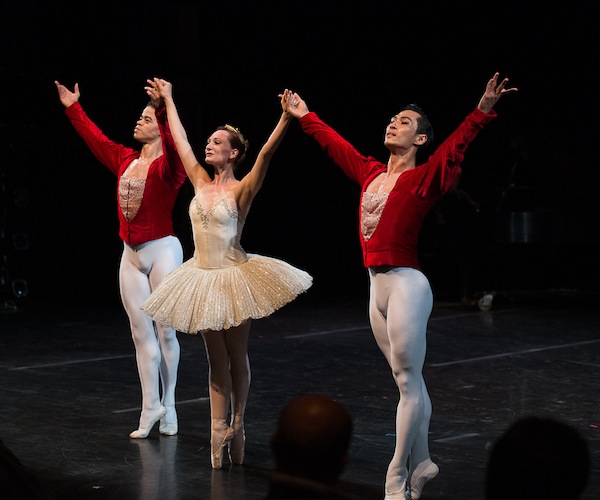Dance Feature: Jacob’s Pillow Archive — Rebooted
Jacob’s Pillow’s revamped archive is a sort of museum as well as a library. A catalogue of the holdings is in the works and should be on line by the end of the year.

The ribbon-cutting ceremony at Blake’s Barn. Executive and Artistic Director Ella Baff, Director of Preservation Norton Owen, and Board Chair Mark Leavitt. Photo: Morah Geist.
By Marcia B. Siegel
A dance archive is more than the documents it preserves. On June 23rd the newly expanded archive at Jacob’s Pillow was launched with a ribbon-cutting ceremony and associated festivities. The previous facility ocupied a smallish room barnacled to the larger Blake’s Barn. Now the few video monitors have multiplied, books have been moved up from storage, and the whole space is higher, brighter, and more convenient for a visitor to do a bit of meandering through the collection.
The Pillow archive doesn’t aim to duplicate the holdings at Lincoln Center’s vast Jerome Robbins Dance Division, but it takes off from the work of the Pillow’s founder Ted Shawn, who’s still revered as a kind of household god there. Shawn’s career in the early 20th century led to other luminaries of the constantly expanding realm of modern dance. As do similar collections, the JP archive holds press announcements, posters, personal records and letters, photographs, films and videos. It also holds iconic objects touched by the greats, like costumes, craft pieces, and notebooks. So the archive is a sort of museum as well as a library. A catalogue of the holdings is in the works and should be on line by the end of the year.
The archive occasion Tuesday also celebrated Norton Owen, who has served the Pillow in many capacities over four decades. For the past 20 years as head of the archive he’s expanded the collection, supervised exhibits in the adjacent Blake’s Barn, curated the popular lecture series of Pillow Talks, and most recently created an interactive website where the public can see film clips from as early as the 1930s through recent Pillow festivals. Michelle Dorrrance’s The Blues Project returns to the Pillow this week; it was recorded at the Pillow in 2013.
Though Ted Shawn and his partner Ruth St. Denis are acknowledged among the initiators of modern dance, they explored all forms of dance in their own choreography. Even ballet got recognized in early days at Jacob’s Pillow. During the l950s, when ballet and modern dance weren’t on speaking terms, the Pillow Dance Festival presented performances by touring dancers from the Royal Danish Ballet and famous soloists like Alexandra Danilova.
A thrilling and daring project was part of the festivities around the opening of the archive. Dancers from the New York Theatre Ballet revived a 1952 work by the great English-American choreographer Antony Tudor. NYTB is noted for its historic repertory as well as contemporary works. Artistic director Diana Byer was looking to bring back a lost dance, and Norton Owen recalled that the Tudor work Trio Con Brio had been produced at the Pillow and filmed. Owen wasn’t sure how much of the piece existed on the silent 16 millimeter film, until a viewing revealed almost the entire 14-minute work was there. The archive also yielded an audio recording of the piano score — selections from Mikhail Glinka’s Ruslan and Ludmilla—which had been made at the time for rehearsal and performance purposes. The combination would make a reconstruction possible.
Using the two archival records, Diana Byer set the steps on three NYTB dancers, Amanda Treiber, Choong Hoon Lee, and Steven Melendez. To cover gaps in the film’s information, dancer Lance Westergard, a disciple of Tudor, created new choreography using Tudor’s step-combinations. Antony Tudor (1908-1987) was best known for his dramatic dances, Pillar of Fire, Lilac Garden, Dark Elegies, Gala Performance, and Undertow among others But he did create plotless classical works to challenge the abilities of dancers at the Metropolian Opera, where he headed the ballet company in the 1950s, and the Juilliard School after the establishment of the dance department there in 1951.

Steven Melendez, Amanda Treiber, and Choon Hong Lee of New York Theatre Ballet in Antony Tudor’s “Trio Con Brio.” Photo: Christopher Duggan.
The whimsically titled Trio Con Brio was originally commissioned by the Pillow for a group known as the Jacob’s Pillow Festival Company. After its premiere summer at the festival in 1952, Trio Con Brio went into that group’s touring repertory, along with a typically eclectic group of dancers including Ted Shawn, the ethnic dancer La Meri, modern dancer Myra Kinch, and a ballroom team. New York Theatre Ballet has been performing the reconstructed work in repertory, and the performance at Jacob’s Pillow (accompanied by pianist Michael Scales) was considered a homecoming for it.
At first it looked unusually traditional for a Tudor work. Ballerina Treiber wore pointe shoes, tutu and tiara; the two men were in white tights and aristocratic red jackets. As the work progressed, with the two men partnering the woman in formal greetings and displays of a meticulous classical vocabulary, I noticed unexpected sequences of steps and behaviors. Treiber would do a seemingly standard phrase, then reorganize or reverse the steps. She’d fall back into a partner’s arms when you expected her to finish a phrase and regain her balance. Her solo variation was filled with small step combinations and understated arms that reminded me of the complex idiom of the 19th century choreographer August Bournonville, and the finale had all three dancers offering the more flamboyant displays of the czardas.
Yet another set of links between Jacob’s Pillow history and the dance of the present was brought to life at the opening with a Pillow Talk by dance historian Sasha Anawalt in conversation with Norton Owen. Anawalt, a dance writer and now associate professor and director of the USC Annenberg Master’s Program in Arts Journalism, came to the Pillow as a teenager in the 1960s. She recalled Shawn’s lectures on the theories of François Delsarte. Shawn had studied with Delsarte’s American interpreters, basing his own dancing on the Delsartian ideas about how body movement communicates emotion. Anawalt engagingly demonstrated Delsarte’s tripartite divisions of the body (the head conveys intellectual ideas; the torso is associated with the spiritual; the lower body the physical), and invited the audience to experience these zones of expression in a few basic moves of our own. She showed film clips including a silent but nonetheless informative lecture-demonstration by Shawn himself.
Internationally known writer, lecturer, and teacher Marcia B. Siegel covered dance for 16 years at the Boston Phoenix. She is a Contributing Editor for the Hudson Review. The fourth collection of Siegel’s reviews and essays, Mirrors and Scrims–The Life and Afterlife of Ballet, won the 2010 Selma Jeanne Cohen prize from the American Society for Aesthetics. Her other books include studies of Twyla Tharp, Doris Humphrey, and American choreography. From 1983-1996 Siegel was a member of the resident faculty of the Department of Performance Studies, Tisch School of the Arts, New York University.
Tagged: Blake's Barn, Jacobs-Pillow, Marcia B. Siegel, New York Theatre, Ted Shawn, ballet, dance archive

Just to add that Jacob’s Pillow christened the reading room in Norton Owen’s honor, guaranteeing that his own achievements will be recognized as long as the Pillow does. It couldn’t have been more apt.